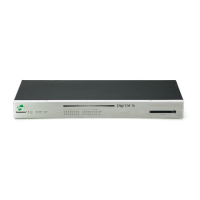System administration Automatically upgrade the Digi CM Unit’s firmware or configuration using TFTP
Digi CM User Guide 142
Syntax for action 2: configuration upgrade
<image name>,<model name>,<version>
<image name> specifying the path and the filename of the configuration file on the TFTP server
<model name> specifying the product name especially the port count e.g. DigiCM48, DigiCM32,
DigiCM16 or DigiCM8
This allows you to have one hash file for different models.
<version> the version number of the firmware
The Digi CM unit will download the configuration if the version in the hash file is different from the
version saved in the file /tmp/cnf/.cnfversion. This file does not exist until you do the first automatic
configuration upgrade. It is also deleted if the unit is reset to factory defaults.
If the /tmp/cnf/.cnfversion file does not exist, no download will occur. The file /tmp/cnf/.cnfversion
is a hidden file.
Example:
config.tar.gz,DigiPassport48,v1.6.0
After the firmware configuration is upgraded the Digi CM unit boots again.
A sample hash file can be downloaded from: https://www.digi.com/products/consoleservers/
digicm#productsupport.
Syntax for action 3: file upgrade
<file name>,<options>,<destination>
<file name> specifying the path and the filename of the file on the TFTP server
<options>
- F: forced copy (override existing file)
- X: decompress
- Z: unzip
- U: default option for file uploading
<destination> directory on the Digi CM unit to place the file
These files are downloaded every time the Digi CM unit boots and there is no reboot after
downloading.
Example:
snmpd.conf,FU,/tmp/cnf
The file snmpd.conf is copied from the TFTP server and placed into /tmp/cnf. The file is used as is
and the previous version is overwritten.
Syntax for action 4: execute a command
<command> <parameters>
<command> any application residing on the Digi CM unit that is executable by root
<parameter> all parameters this application requires
Example:
touch /tmp/test

